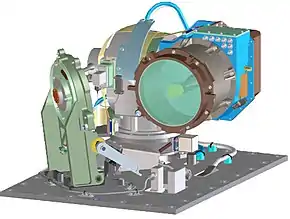Laser Communications Relay Demonstration
The Laser Communications Relay Demonstration (LCRD) is a NASA mission that will test laser communication in space for extremely long distances.[1]
It is integrated into STPSat 6, part of STP-3, currently due to launch in 2021.[2]
Overview
The LCRD mission was selected for development in 2011, with launch on board a commercial satellite scheduled for 2019.[3] The technology demonstration payload will be positioned above the equator, a prime location for line-of-sight to other orbiting satellites and ground stations. Space laser communications technology has the potential to provide 10 to 100 times higher data rates than traditional radio frequency systems for the same mass and power. Alternatively, numerous NASA studies have shown that a laser communications system will use less mass and power than a radio frequency system for the same data rate.[4]
The LCRD mission is managed by NASA's Goddard Space Flight Center.[4]
In May 2018 the General Accounting Office says there have been delays, funding cuts, and cost overruns but it should be ready to launch by November 2019,[5] as a payload on a U.S. Air Force Space Test Program mission STP-3, on an Atlas V 551.[6]:65
By April 2020, after further delays and cost overruns, it was expected to launch in Jan 2021, as a payload on a U.S. Air Force Space Test Program satellite (STPSat 6, part of STP-3 launch).[7]
Precursor mission

The concept was first tested in outer space aboard the Lunar Atmosphere and Dust Environment Explorer (LADEE) orbiter in 2013. LADEE's Lunar Laser Communication Demonstration (LLCD) pulsed laser system conducted a successful test on October 18, 2013, transmitting data between the spacecraft and its ground station on Earth at a distance of 385,000 kilometres (239,000 mi). This test set a downlink record of 622 megabits per second (Mbit/s) from spacecraft to ground, and an "error-free data upload rate of 20 Mbps" from ground station to spacecraft.[8][9] It has also been proposed as payload for the Phobos And Deimos & Mars Environment (PADME) orbiter.[10]
See also
- European Data Relay System, optical links, since 2016
- Laser space communication
- Mars Telecommunications Orbiter, cancelled, but would have included laser demo.
- OPALS, laser comms test, tested from ISS from 2014.
- Deep Space Optical Communications, demo to fly on Psyche spacecraft in 2022
References
- "Laser Comm: That's a Bright Idea (video)". NASA. September 11, 2012.
- NASA's Next Laser Communications Demo Installed, Integrated on Spacecraft July 2020
- Laser Communications Relay Demonstration (LCRD) Overview. Lee Mohon, NASA TV. 3 August 2017.
- "Goddard Press Release No. 12-074". NASA Goddard Space Flight Center. Archived from the original on 2013-02-15.
- GAO assessment of LCRD May 2018
- NASA GAO Assessment of major projects 2018
- NASA Laser Communications Project Running Behind Schedule, Over Budget June 2020
- Messier, Doug (October 22, 2013). "NASA Laser System Sets Record with Data Transmissions From Moon". Parabolic Arc. Retrieved December 19, 2013.
- "Lunar Laser Communication Demonstration Reveals Bright Future For Space Communication". NASA. Red Orbit. December 24, 2013. Retrieved 2014-10-12.
- Reyes, Tim (1 October 2014). "Making the Case for a Mission to the Martian Moon Phobos". Universe Today. Retrieved 2014-10-05.
External links
